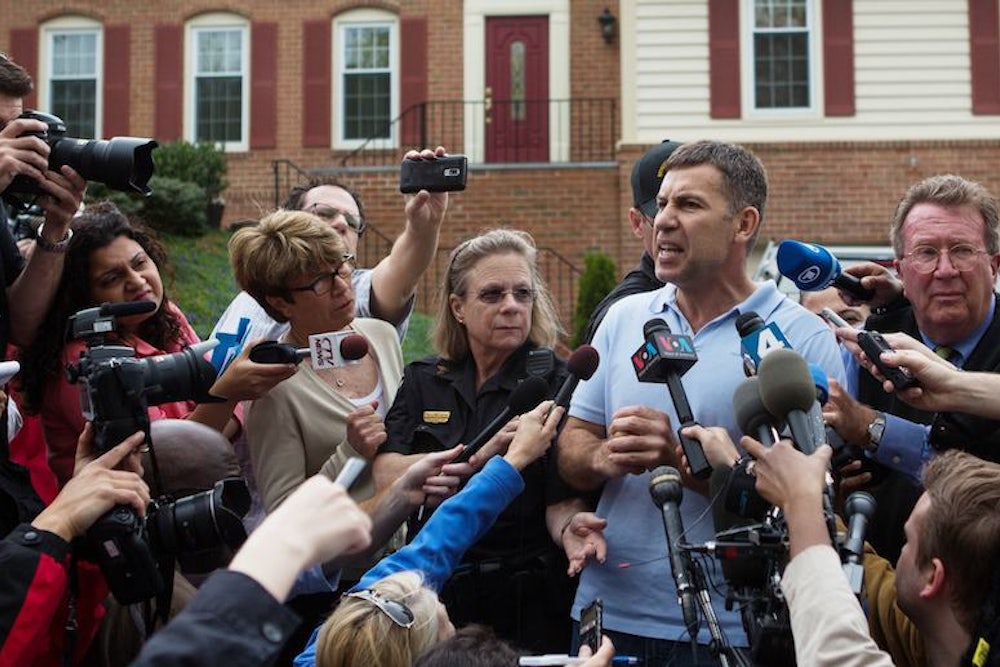As TV networks scrambled Friday to chronicle the manhunt unfolding on live TV, they undertook the parallel project of compiling a portrait of the suspects. Testimonies from classmates of 19-year-old suspect Dzhokar Tsarnaev sounded the refrain of his ordinariness. He took acting and advanced placement courses in high school. In college he played soccer and got high. He seemed by all accounts like a pleasant, mild kid enmeshed in a network of friends. “THOSE WHO KNEW SUBJECT #2 ARE SHOCKED,” read the ticker on CNN at one point.
Details trickled in about the older brother, too, albeit less sympathetic ones: We learned that the 26-year-old who died in a shootout with authorities early this morning was a boxer, that he had attended Bunker Hill Community College, that he once allegedly wrote, “I don’t have a single American friend, I don’t understand them.” But as the procession of testimonials was trotted out on behalf of 19-year-old Dzhokar—someone who lived three doors down from him at UMass-Dartmouth, several high school classmates, his employer from his job as a lifeguard at Harvard—Tamerlan began to feel like the shadowy black hole at the center of the broadcast coverage. “[Dzhokar] was a very nice guy, I knew him for about four or five years, everytime I saw him, he would keep smiling,” one friend of the 19-year-old told a reporter. “He never mentioned his older brother.”
It makes sense, of course, that the bulk of the character development on live TV would focus on the then-live fugitive, on the object of the chase unfolding in front of us. But the result was that, in a typically neat bit of broadcast media pop psychology, the 19-year-old emerged instantly as a wayward youth strong-armed by his brother into butchering a crowd of innocents. “People are convinced that it was the older brother who would have talked him into committing such a heinous act,” said one reporter on CNN. Of course, this was the same 19-year-old who, police said, ran over his brother's body with his car to escape authorities; who was thought to have more explosives strapped to his body; who was photographed lurking near eight-year-old Martin Richard as the boy, who would die in the blast, peered over a railing to watch his father cross the marathon finish line. But the one coherent narrative in a day of total narrative confusion—in which nothing was certain until the very end, and reporters became participants in the mayhem (“Police just told me that if we knew what was going on, I wouldn’t be standing here right now,” said Kerry Sanders at one point on NBC)—was the relationship between the brothers: the dominant brother and the subservient brother, the criminal mastermind and the sad sidekick. Regardless of how legitimate the narrative ultimately proves, said Bruce Shapiro, the executive director of the Dart Center for Journalism and Trauma at Columbia University, “we are seeing the seeds of myths being laid in these first hours” of TV coverage. The media, after all, has always loved a criminal duo.
“Dyad” is the FBI’s term for a pair of killers who jointly concoct and carry out a crime. Frank Ochberg, a forensic psychiatrist who has specifically studied dyads, told me that he has tried to convince the FBI to create a database of dyads because profiling criminals who work in tandem is different from profiling individuals, and in the absence of hard criteria the psychological profiles for criminal duos tend to be mostly anecdotal. “What we are seeing unfold on the news right now, Ochberg said, “is absolutely a premature narrative.” And when the Beltway sniper attacks terrorized the D.C. area over a decade ago, the culprits were discovered to be two men, one nearing middle age and one a teenager. As a way to lend one legible narrative to a messy and evolving story, the media jumped to assign a father-son dynamic to the men, who were not biologically related. “The way we can concretize our perception of the evil, corral it into explainable nugget, is by saying there is one evil person influencing the team, the duo,” said Angie Chuang, a media professor at American University’s School of Communication.
Before the Washington snipers there was Dylan Klebold and Eric Harris, perhaps the most notorious dyad in recent media memory. In the definitive account Columbine, Dave Cullen bemoans the rush to impose a false narrative on the Klebold-Harris relationship. As Cullen told me, “the media narrative was that these were two bullied outcasts from the trench coat mafia exacting revenge on jocks. And every single one of those phrases I just threw out ended up being completely wrong.” Cullen is now often solicited by the media to speculate about the dynamic in criminal dyads. So he has adopted what he calls an “on camera, off camera duality" in his thinking. When we spoke he had just gotten off the phone with Mary Ellen O’Toole, formerly one of the FBI’s top profilers. “We just openly conjectured about [the Tsarnaev brothers] for awhile,” Cullen said. “But with you,” Cullen told me, “I have to go into a completely different mindset. It is not okay to conjecture, to talk in terms of possibilities in the media; it would be irresponsible to do that on the air.” Set to appear later Friday on MSNBC's “All In with Chris Hayes,” Cullen said he was determined to remind viewers that “these things are rarely what they seem.”
If the strangeness of Monday’s broadcasts was witnessing the total informational meltdown on CNN, part of the strangeness of today’s TV coverage was that it left the older brother, as a character, balefully dim. In a powerful phone interview with Boston's CBS affiliate Friday morning, the brothers’ uncle Ruslan Tsarni recalled telling the 26-year-old in 2009, "You prick"—perhaps the most direct and vivid description we heard of Tamerlan in all the chaos of Friday's chase.
